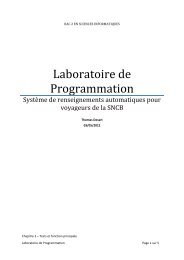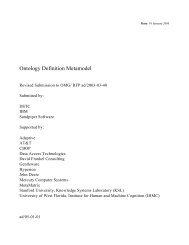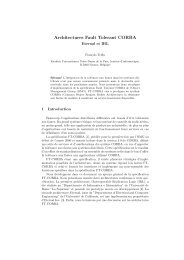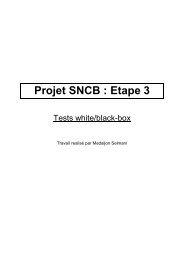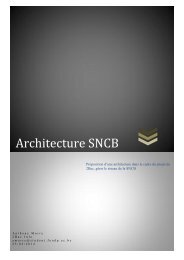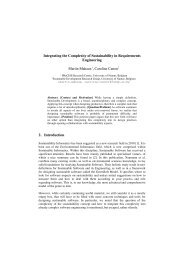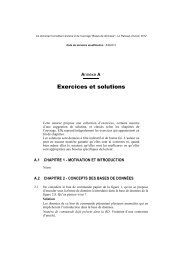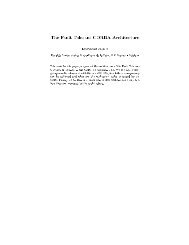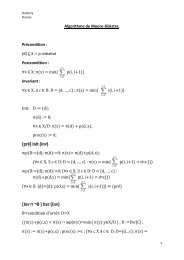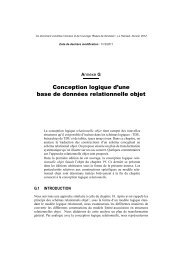Database Reverse Engineering - A Case Study - Institut d'Informatique
Database Reverse Engineering - A Case Study - Institut d'Informatique
Database Reverse Engineering - A Case Study - Institut d'Informatique
Create successful ePaper yourself
Turn your PDF publications into a flip-book with our unique Google optimized e-Paper software.
4.1 DMS-DDL text ANALYSIS<br />
This operation is carried out by a COBOL parser which extracts the file and record descriptions, and<br />
expresses them as a first cut schema in the repository. The resulting schema is given in Figure 2.<br />
Each record type is represented by a physical entity type, and each field by a physical attribute. Record keys<br />
are represented by identifiers when they specify uniqueness constraints and by access keys when they specify<br />
indexes. Files are represented as physical entity collections (cylinder icons).<br />
ORDER<br />
ORD<br />
ORD-CODE<br />
ORD-CUSTOMER<br />
ORD-DETAIL<br />
id: ORD-CODE<br />
acc<br />
acc: ORD-CUSTOMER<br />
STOCK<br />
STK<br />
STK-CODE<br />
STK-NAME<br />
STK-LEVEL<br />
id: STK-CODE<br />
acc<br />
CUSTOMER<br />
CUS<br />
CUS-CODE<br />
CUS-DESCR<br />
CUS-HIST<br />
id: CUS-CODE<br />
acc<br />
Figure 2. The first cut file and record schema as produced by the COBOL parser of DB-MAIN.<br />
The textual view shows the type and length of the fields :<br />
Schema CUST-ORD/1stCut-Logical<br />
collection CUSTOMER<br />
CUS<br />
collection ORDER<br />
ORD<br />
collection STOCK<br />
STK<br />
CUS<br />
in CUSTOMER<br />
CUS-CODE char(12)<br />
CUS-DESCR char(80)<br />
CUS-HIST char(1000)<br />
id:CUS-CODE<br />
access key<br />
ORD<br />
in ORDER<br />
ORD-CODE numeric(5)<br />
ORD-CUSTOMER char(12)<br />
ORD-DETAIL char(200)<br />
id:ORD-CODE<br />
access key<br />
access key:ORD-CUSTOMER<br />
STK<br />
in STOCK<br />
STK-CODE num(5)<br />
STK-NAME char(100)<br />
STK-LEVEL num(5)<br />
id:STK-CODE<br />
access key<br />
4.2 PROGRAM ANALYSIS<br />
This schema will be refined through an in-depth inspection of the ways in which the program uses and<br />
manages the data. Through this process, we will detect additional structures and constraints which were not<br />
explicitly declared in the file/record declaration sections, but which were expressed in the procedural code and<br />
in local variables. We will consider four important processes, namely Field refinement, Foreign key<br />
elicitation, Attribute identifier elicitation, and Field cardinality refinement.<br />
4.2.1 Field refinement<br />
First observation : some fields are unusually long (CUS-DESCR, CUS-HIST, ORD-DETAIL, STK-NAME).<br />
Could they be further refined ? Let us consider CUS-DESCR first. We build the variable dependency graph,<br />
which summarizes the dataflow concerning CUS-DESCR (statements [1] and [1']) :<br />
CUS.CUS-DESCR<br />
DESCRIPTION<br />
This graph clearly suggests that CUS-DESCR and DESCRIPTION should have the same structure, i.e. :<br />
[1']<br />
[1]<br />
FIIA96 (04/04/07) 4



